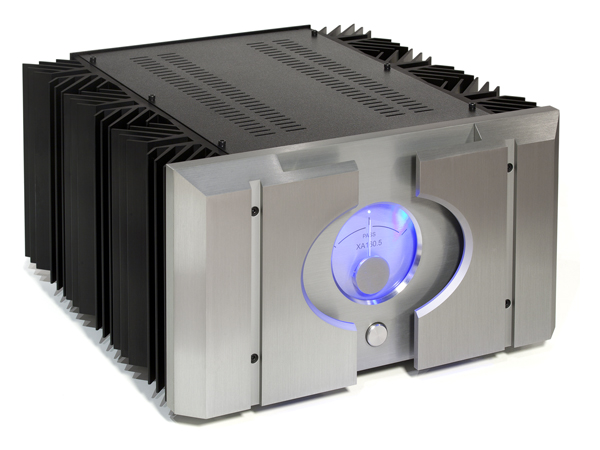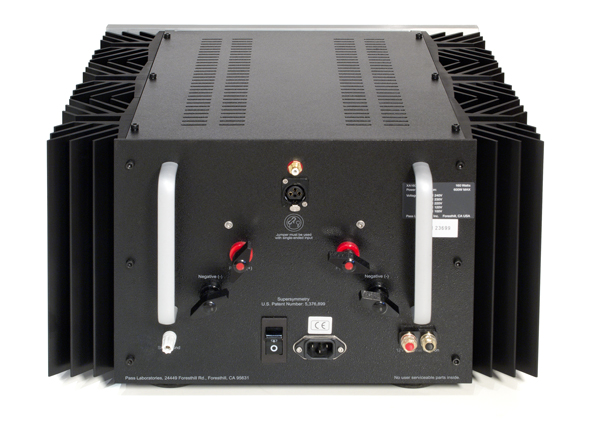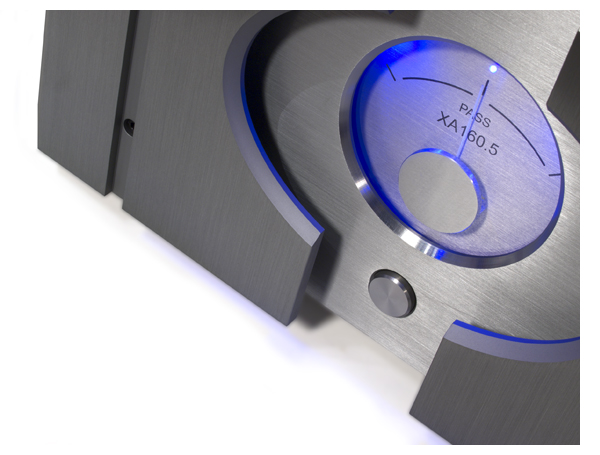Pass XA160.5 Monoblock Amplifiers Simply Monstrous
By Jeff Dorgay No matter your drug of choice—chemical, horsepower, audio—with prolonged use, you always reach a plateau at which you believe you just can’t get any higher. But sooner or later, something else enters your reality that restarts the cycle, and you’re off and running again. Such is my experience with the Pass Labs XA160.5 monoblocks.
No matter your drug of choice—chemical, horsepower, audio—with prolonged use, you always reach a plateau at which you believe you just can’t get any higher. But sooner or later, something else enters your reality that restarts the cycle, and you’re off and running again. Such is my experience with the Pass Labs XA160.5 monoblocks.
If you are new to the world of high-end audio, you can get the condensed history of Pass Labs here: http://www.passlabs.com/about.htm. The shorter version is simple: Nelson Pass is a genius. He’s probably got more patents for amplifier design than almost everyone else combined. And he’s got a great sense of humor, too. The owner’s manual describes the new amplifier as “tending to run heavy and hot, but elicit high performance and reliability from simple circuits.”
Weighing in at about 130 pounds each and $24,000 per pair, the XA160.5s are not for the light of wallet—or bicep. Or, for that matter, air-conditioning capacity. The power draw isn’t huge, but each unit sucks 600 watts from the power line, whether idling or at full power. Because they only produce 160 watts per channel into 8 ohms, doubling into a 4-ohm load, they get very warm to the touch. Yes, this behavior is normal for a class A design. The extra heat was welcome in March when the amplifiers arrived, as it kept our studio toasty. Yet, as days got longer, the amps forced us to run the A/C well before we normally would.
Super Yet Simple
Pass has always advocated keeping things as simple as possible. While squarely looking at the enormous monoblocks might cause you to question whether he still believes in this basics-minded philosophy, thanks to Pass’ patented SuperSymmetry design, the amplifier has only two gain stages. At the risk of oversimplifying, the SuperSymmetry approach achieves low distortion (and tonal purity) by making each half of the balanced amplifier as close to identical as possible so that the resulting distortion from each half of the amplifier circuit cancels out in balanced mode.
To achieve maximum performance, the amplifier must be run in balanced operation. Fortunately, the ARC REF 5 offers balanced and single-ended outputs, which makes comparisons a snap. And Pass is right again: Utilizing the XA160.5 in single-ended mode proved very good, but it featured a layer of grain not present in balanced mode. Whether you use a Pass Labs preamplifier or a model from another manufacturer, make sure to take the balanced route.
Coming Full Circle
My first experience with Pass’ class A amplifiers came in 1979. I combined a Threshold 400A with a Conrad Johnson PV-2 preamplifier driving a pair of Acoustats, making both an incredibly natural combination and excellent case for pairing a solid-state power amplifier with a tube preamplifier. While many combinations have since passed through my room, the tube pre/solid-state power amplifier is always the one to which I’m drawn, especially when it involves a class A amplifier.
The XA160.5s symbiotically works with all of the preamplifiers at my disposal, but the match with the Audio Research REF 5 linestage and REF Phono 2 preamplifier is heaven-sent. Pass Labs president Desmond Harrington tells me that many customers use the company’s amplifiers with tube preamplifiers. “It’s a popular combination, but when it comes to power, we like to see our amplifiers offering the tube sound without the tears.” Truer words haven’t been spoken.
As someone who’s purchased more than a fair share of power tubes, I am relieved to know that the sound of the XA160.5’s will never change. And, you won’t have to buy new power tubes every year. Continuous operation cuts down on tube life. If only Costco sold tubes by the palette.
Like Luke, I Ignored Yoda Just Once
Pass’ instruction manual cautions against using the XA160.5s with a power conditioner. Nonetheless, I plugged them directly into the wall and then into my Running Springs Maxim power conditioner, with the latter providing an even cleaner presentation. The soundstage opened up significantly, and I didn’t experience any loss of dynamics. Yes, the stock power cords that come with the XA160.5s are very good, but aftermarket power cords (Shunyata and Running Springs models yielded excellent results) offered up a slightly clearer window to the music.
In all fairness, think of superior power cords as being able to take an amplifier that goes to 11 up to 11.2. Besides, you wouldn’t put regular gas in your Porsche, would you?
Unlike a non-class A solid-state amplifier, the XA160.5s shouldn’t be powered on for 24 hours a day. They generate too much heat. Still, just like a tube amplifier, the XA160.5s need an hour to warm up and stabilize. At first turn on, they still sound great, but once you get used to them, you’ll notice a slight haziness that softly dissipates as the clock ticks. Coincidentally, the ARC REF 5 and REF Phono 2 need an hour to sound their best, too, so if you are using a tube front end, everything will warm up at the same pace.
I initially listened to familiar digital tracks from the Sooloos music server/dCS Paganini combination. I was immediately taken aback by the additional weight and depth, even more so with high-resolution digital files. All of the class A amplifiers with which I’ve lived share a tonal richness that other solid-state amplifiers do not possess. Some might refer to this quality as warmth, but I prefer to call it tonal richness. I associate warmth with slowness, lack of pace, and rounded-off treble; the XA160.5s exhibited none of these characteristics. The Pass monoblocks sport the equivalent of a great guitar’s ability to sustain a note. On a choice Gibson Les Paul, for example, music just seems to hang in the air a little longer.
Switching back and forth between amplifiers at my disposal revealed that the XA160.5s are indeed very special. It was as if the particular characteristics from my favorite amplifiers have somehow taken up residency in one model. Thanks to their monoblock design and huge power supplies (the 160.5 is claimed to have a significantly larger power supply than the 160 it replaces), these amplifiers throw a soundstage that is prodigious in all three dimensions. Image width really stands out.
I noticed such traits on all program material, but they became more obvious when listening to classical. Conveying the size of a symphony orchestra—much wider than most listening rooms—is one of the toughest feats to ask a system to accomplish. When listening to Sir Arnold Bax’s sixth symphony, it felt as if the sidewalls in my listening room had been each moved out about six feet. Not realistic, of course, but much more convincing than without the XA160.5s.
Recorded live and flush with ambience, Hugh Masekela’s “Stimela (The Coal Train)” from Analogue Productions’ 45RPM 2LP version of Hope provides an excellent test. Having just heard Masekela perform the song at the Montreal International Jazz Festival in June, the recorded version via the Pass amps colored me impressed. While the live version claimed a slightly different arrangement, the XA160.5s pushed my GamuT S9s to a realistic sound level and conveyed such nuance and tonal contrast, I felt like I was back in Montreal’s Club Soda venue. Even at the high volume level, the front panel’s deep-blue backlit oval meter barely flinched from its center position, indicating that the amplifier never left class A mode.
Of course, man cannot live on jazz alone. At prime operating temperature, the XA160.5s did not miss a beat on a Japanese vinyl pressing of Michael Schenker’s Built to Destroy. No matter how hard I pushed, I could not destroy the amps or my speakers. And yes, that’s a very good thing. Staying in Japanese LP mode, Bruce Springsteen’s The Wild, The Innocent, and the E-Street Shuffle proved tough to resist, as did David Bowie’s Aladdin Sane. These old favorites never sounded better, and when I quickly switched back to the gear I’ve lived with for some time, across-the-range performance boosts became manifest.
Staggering Pace and Tonality
While classical music plays to one group of the XA160.5s strengths, revisiting the recently remastered Beatles catalog plays to another: These amplifiers offer rock-solid pace. Violins in the mono version of “Eleanor Rigby” (from Revolver) were strongly anchored, and Lennon and McCartney’s voices unwavering. There was so much depth, it almost sounded like a stereo recording! Speaking of the latter, the stereo version of “Penny Lane” from Magical Mystery Tour turned out to be just as exciting. Ringo Starr’s drumming and McCartney’s bass held true throughout the psychedelic soundscape.
I am easily swayed by the big sound of these amplifiers, yet that characteristic only scratches the surface of their capabilities. Concerning tonal accuracy and texture? Spot on. Acoustic instruments sound correct, whether listening to wind, string, or percussion instruments. Dynamic contrasts equate to the best I’ve experienced. A few TONE writers whose tastes skew towards classical remain astonished at the lifelike piano reproduction.
Music fans that crave vocal performances will benefit from the XA160.5’s picture-perfect tonality and resolution. Again, the extra tonal body almost feels as if one is listening to an SET—albeit an SET with nearly unlimited power that you can use with real-world speakers. The extra low-level resolution goes a long way, especially when spinning marginal discs. An ideal example comes courtesy of Keith Richards’ Talk is Cheap. Richards is not known for possessing a terribly strong lead vocal. Yet, when put through the XA160.5s, it actually has some depth. Such is the XA160.5s’ allure. They hover at the optimum point of boasting maximum resolution without being harsh, sounding full bodied and musically natural without introducing tonal distortion— a difficult balancing act.
Bass response keeps in line with the exceptional performance found elsewhere in the frequency range. While the XA160.5s have more than ample weight and slam, the bass reveals a level of texture and detail that I’ve only experienced with a small handful of amplifiers. Remember: It’s easy to confuse “audiophile bass” (usually over-damped and distinguishable from the real thing that has life, texture, and resonance); the XA160.5’s are the genuine article. A cursory listen to your favorite acoustic bassist reveals the way these amplifiers allow the instrument to breath, and brings you that much closer to the actual performance.
Two years ago, I proclaimed the Burmester 911 Mk.3’s the best amplifiers I’ve heard. And over the course of hundreds of product reviews, I’ve used that dreaded “B” word just once in the absolute sense. After conveying my enthusiasm for these amplifiers to Harrington, he responded, “The 160’s are amazing, but you need to hear the 200s.” So just when I thought I couldn’t get any higher, the quest begins again.
It’s always tough to make comparisons, yet the XA160.5 combines the virtues of my three favorite amplifiers into one (actually two) boxes: the delicacy of the Wavac EC300B, the texture and dimensionality of the ARC REF 150, and the power, control, and composure of the Burmester 911s.
Independent of the “B” word, the Pass Labs XA160.5 monoblocks orbit the top stratosphere of amplifier design at any price. If you would like that je ne sais quoi that you thought required a vacuum-tube amplifier, these are a consummate alternative. There is nothing that the XA160.5s do not do.
The Pass Labs XA160.5 monoblocks
MSRP: $24,000/pr.
Peripherals
| Analog Source | Audio Research REF Phono 2 AVID Acutus Reference SP w/SME V tonearm and Koetsu Urushi Blue cartridge AVID Volvere SP w/SME 309 tonearm and Grado Statement1 cartridge |
| Digital Source | dCS Paganini stack Sooloos Control 15 |
| Preamplifier | Burmester 011 Burmester 088 ARC REF 5 McIntosh C500 Conrad Johnson ET5 |
| Speakers | GamuT S9 |
| Power | Running Springs Dmitri Running Springs Maxim |
| Accessories | Furutech DeMag Loricraft RCM |





